One of the well-known signature features of Rome is its wonderful fountains. Despite the numerous landmarks in the city, fountains stand out, and rightly so, on their own as one of the leading attractions in Rome. They are an architectural wonder of both modern and ancient Rome and serve a wide range of purposes including places for city dwellers to relax, venue for street performances, and gathering places for tourists and locals. The story behind the many fountains in this city is fascinating. It is believed that the Romans constructed many fountains so that the soothing sound of flowing water could counteract the traffic noise.
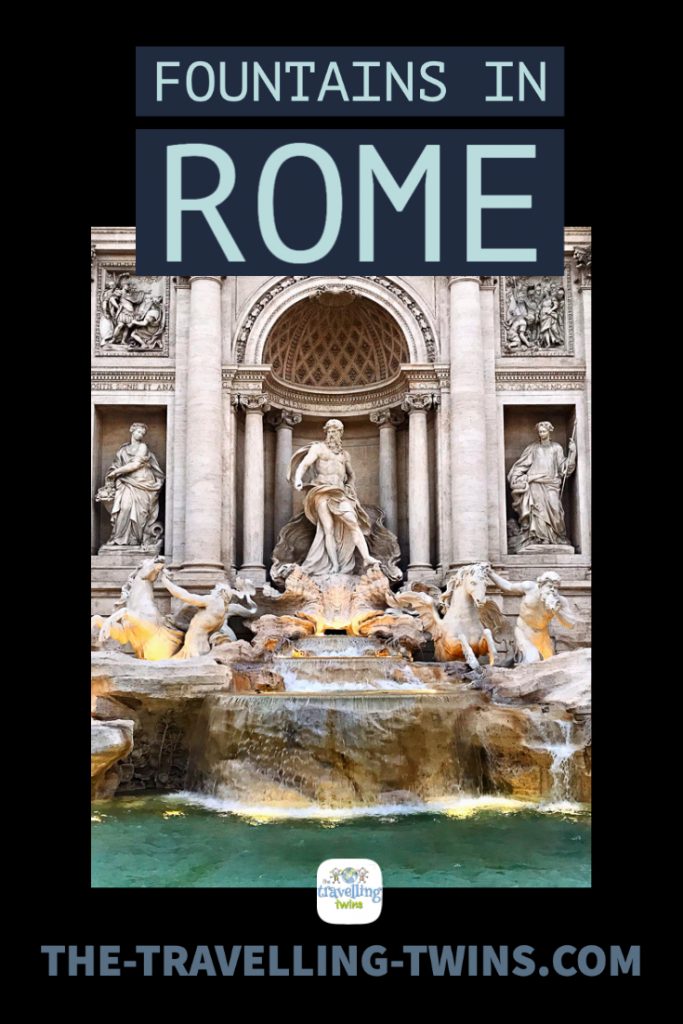
How Many Fountains are in Rome?
Rome is home to more than 2,000 fountains, with the oldest one being over 2,000 years old. These fountains are tightly intertwined in the city’s loft history of power and wealth.
Some of these fountains are discussed below.
What is the famous fountain in Rome?
The Trevi Fountain
The most famous fountain in Rome is the Trevi Fountain or Fontana di Trevi in Italian. It is located in the Trevi region of Rome and was designed by architect Nicola Slavi and built by Giuseppe Pannini in collaboration with other architects.
Interestingly, Trevi Fountain is not only famous in Rome but also arguably the most famous fountain in the world.
Many tourists like flocking to the fountain to throw coins in the water so that their wishes may come true. Because of this, it is believed that more than 3,000 euros are collected at the fountain every day. In 2016 alone, there were more than 1.2 million euros was collected from the fountain – Facts about Rome
It is also in Trevi Fountain that Italy Perfect’s author Pat Byrne took a swim on her night of graduation.
La Fontana dei Quattro Fiumi
If the aim of your trip to Rome is to explore its beautiful fountains, the Fountain of the Fours is a must-visit. Located at the center of Piazza Navona, this fountain was designed by Gian Lorenzo Bernini back in 1651 and its foundation is also the base upon which the four river gods are placed.
These four gods represent the biggest rivers from the five continents namely the Nile in Africa, the Ganges in Asia, the Danube in Europe, and the Plate in the Americas.
The fountain of the four rivers was commissioned by Pope Innocent X whose palace is adjacent to Piazza Navona.
Besides the sculpture of the four gods and the fountain, another recognizable landmark around here is the giant Egyptian obelisk at the center, which was supposed to represent the power and status of the papacy.
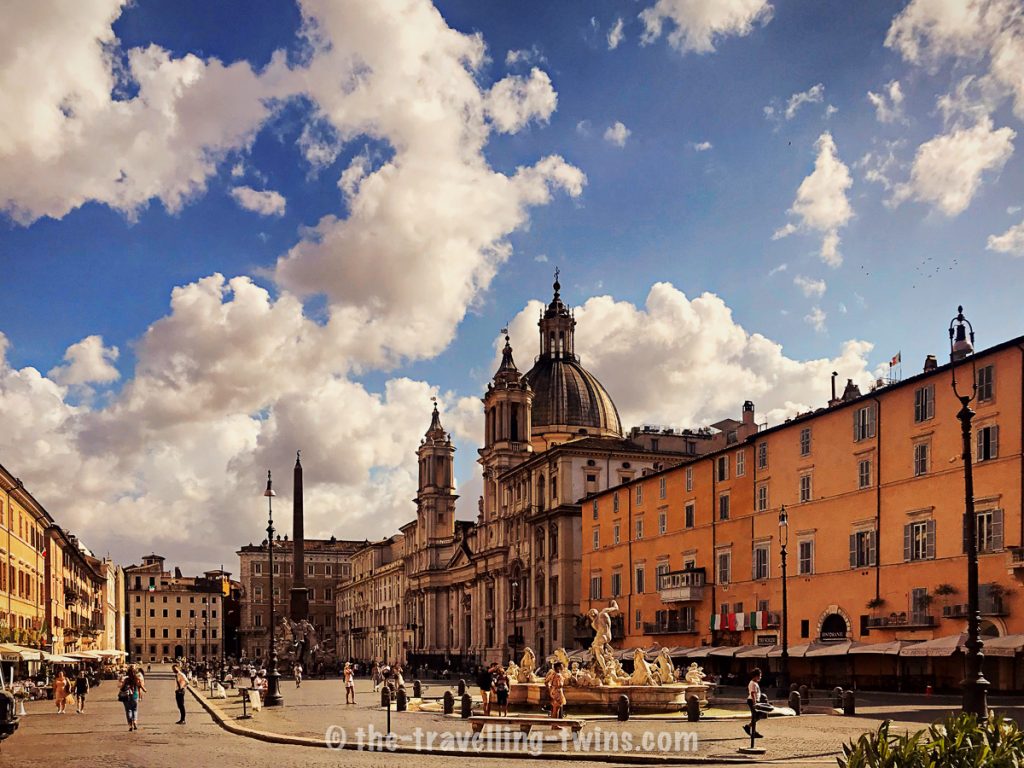
La Fontana del Moro
Located also in Piazza Navona, the Fontana del Moro is designed by Gianlorenzo Bernini and is among the three fountains on this famous Roma Piazza. The fountain was constructed under Pope Innocent X as a part of the La Fontana dei Quattro Fiumi.
La Fontana del Moro was completed in 1654 by Giovanni Antonio Mari using a sketch created by Bernini.
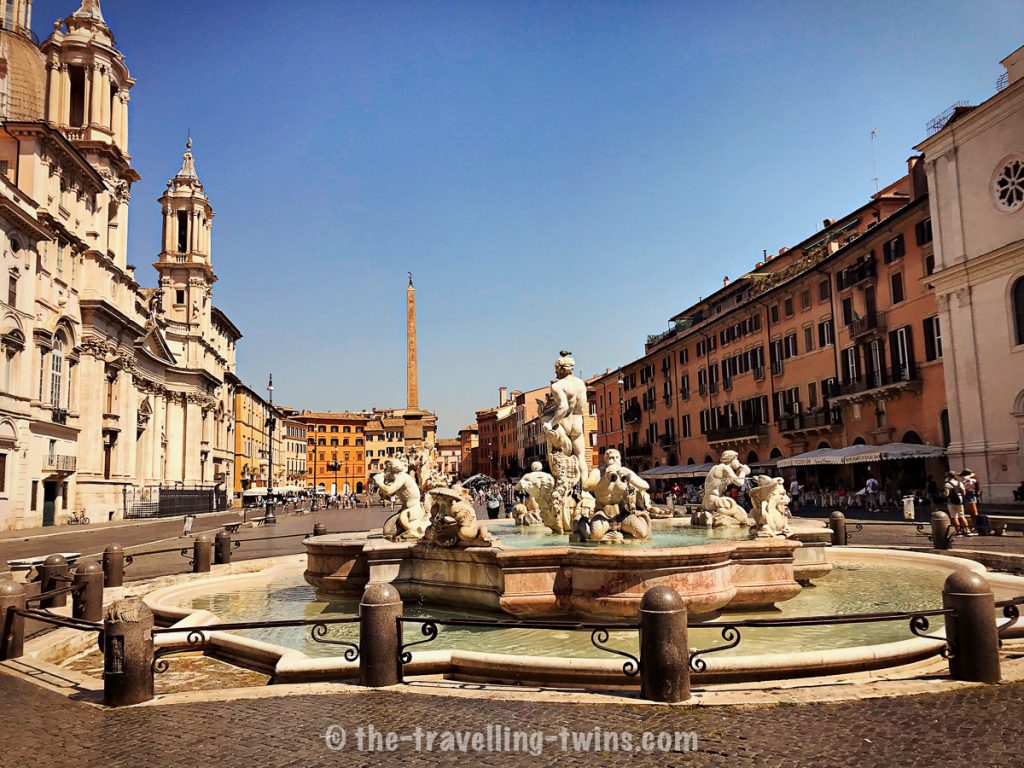
Fontana del Nettuno – Fountain of Neptune
Another fountain near Piazza Navona, Fontana del Nettuno, along with another nearby fountain, Moor Fountain, was designed by Giacomo della Porta also using Bernini sketches and as part of La Fontana dei Quattro Fiumi.
Fountains of St. Peter’s Square
The Fountains of St. Peter’s Square comprises two fountains in Vatican City. They were built by Gian Lorenzo Bernini and Carlo Maderno.
The Maderno Fountain
The oldest fountain in the square is the Maderno Fountain. In 1612, the ancient aqueduct called the Aqua Traiana was restored by Pope Paul V and its name changed to Acqua Paola. The rebuilt fountain supplied enough water to the existing fountain but there was a need for a new spout. Carlo Maderno was commissioned to redesign the new fountain, and therefore he built a huge irregular basin on top of an octagonal base. The basin is adorned with steps and mini-columns to hold the water. The giant lower stone vasque of the old fountain remained but the pedestal above it was decorated with four stone scrolls.
Maderno replaced the upper vasque with a cap resembling a mushroom, covered with stone scales. The fountain was designed in a way that the water spouts from the top, pouring down over the upper vasque, which breaks the flow of water, creating a sparkling spectacle.
The Bernini Fountain
The Bernini Fountain is the second of the Fountains of St. Peter’s Square. It was built commissioned by Pope Clement X some fifty years after the Maderno fountain was built. The fountain is similar to the one built by Maderno and was completed in ten years.
Fontana della Barcaccia
This is one of the most popular fountains in Rome thanks to its great location at the bottom of the Spanish Steps in Piazza di Spagna (Spanish Square). It is also close to another one of the most famous fountains in the city, the Trevi Fountain, which is just 600 meters away.
The fountain was commissioned by Pietro Bernini back in 1623 as part of the previous Papal project to build a fountain in all major piazzas in the city.
Pietro Bernini is the father of Gian Lorenzo Bernini and it is believed that they collaborated in this project.
Fontana dell Barcaccia has a unique shape of a sunken ship with water teeming both of its sides into a small basin.
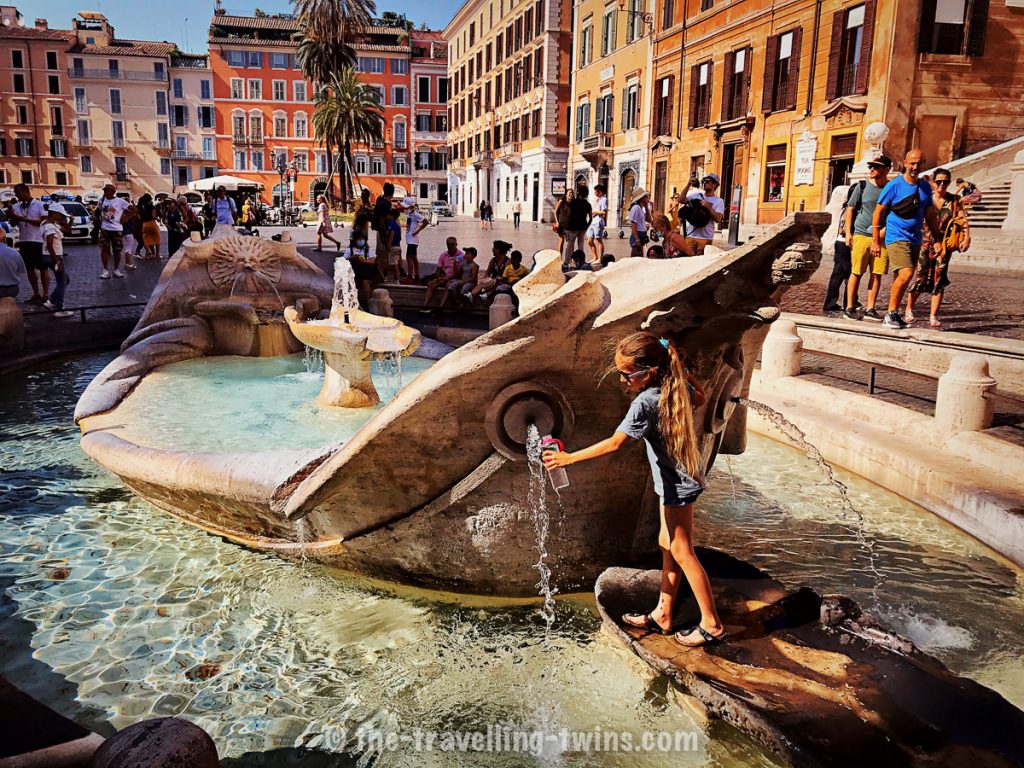
Triton Fountain and Fountain of the Tritons
The Triton Fountain and Fountain of the Tritons are two fountains dedicated to the god of the sea. Their location is believed to be one of the most beautiful places in the city of Rome, which is right at the center of the busy Piazza Barberini.
The fountain was commissioned by Pope Urban VII and designed and built by Bernini. The fountain has a historic importance to the people of Rome as it was the first one to provide water to the public.
Fontana del triton has been providing clean drinking water to the residence since 1643 while the Fountain of the Tritons was completed in 1715 at Piazza Bocca Della Verita.
La Fontana delle Api
Also designed and completed by Bernini, La Fontana delle Api (Fountain of the Bees) is designed to look like a horse watering trough and features a huge shell with three bees on the surface, thus the name “Fountain of the Bees”.
The fountain is also located in Piazza Barberini near Fontana del triton. Despite its tiny stature and being on the shadow of the Fontana del tritone, La Fontana delle Api is one of the most striking fountains in Rome. It is adorned by the official coat of arms for the Barberini family and was commissioned by Pope Urban VIII and built by Lorenzo Bernini in 1644.
Four Fountains on Via delle Quattro Fontane
Referring to four fountains from the Renaissance era, the Quattro Fontane is located at the junction of Via del Quirinale and Via delle Quattro Fontane. They were commissioned by Pope Sixtus V and built by Muzio Mattei from 1588 to 1593.
The first fountain, which can be recognized by its wolf statue, was dedicated to the Tiber River, the second represents the Aniene River, which supplied water to the majority of the city’s aqueducts, and the remaining two were dedicated to two goddesses – Juno the goddess of strength and Diana the goddess of chastity.
Pietro da Cortona and Domenico Fontana are just a few artists that worked on Four Fountains on Via delle Quattro Fontane.
Fountain of the Facchino
Fountain of the Facchino – Fountain of the Porter – is one of the most unique fountains in Rome. Today, there are a total of six talking statues in the city, which were used in ancient times to host public sermon through posters from the 14th and 15th centuries.
This fountain, however, along with the statue, is different from the other six because it was built later by the end of the 1500s and depicts a gentleman who is a water carrier. His name is believed to be Abbondio Rizio, who earned his living by supplying fresh water to residents’ homes. The man is also believed to have possessed some extraordinary strength.
Fontana Dei Libri – Fountain of the Books
This fountain is one of those gems that you bump into while wandering down the narrow streets of the city’s Centro Storico. Fontana dei Libri is a small, beautiful fountain decorated with a deer’s head along with four books, which both symbolizes the district in which the fountain is located as well as the fortification of the Universita della Sapienza.
Fontana dell’Acqua Felice
Also known as the Fountain of Moses, Fontana dell’Acqua Felice is located in the Quirinale district. The aqueduct that supplies water to this fountain was rebuilt by Pope Sixtus V, at the time when Aqua Vergine was the only Roman aqueduct was that still functioning.
Fontana dell’Acqua Felice was actually the first fountain to be built in Rome since antiquity and was designed by Domenico Fontana and completed in 1588. It was inspired by an ancient Roman triumphal arch with its inscription dedicated to Pope Sixtus.
Another notable feature of the fountain is the angels that appear to embrace the papal coat of arms.
Fontana dell’Acqua Paola
Fontana dell’Acqua Paula was built after the work to restore the Acqua Traiana aqueduct was completed. Before it was constructed the residents around the Janiculum Hill were forced to fetch their drinking water from the dirty Tiber River.
To mark the end of the rebuild of the aqueduct, a fountain was erected in 1612 and named after Pope Paul V.
Two architects, Flaminio Ponzio and Giovanni Fontana were tasked with design the fountain. The white marble used to build it was appropriated from the Temple of Minerva and the Forum of Nerva.
Fontana del Peschiera
Located in Piazzale degli Eroi, Fontana del Peschiera is one of the modern fountains in Rome having been built in 1949. The construction faced many hurdles as it was in the aftermath of the Second World War and the country’s economy had suffered significantly.
The fountain was constructed after the completion of the Peschiera aqueduct, which took forty years.
Fontana del Peschiera was inspired by the Najadi fountain.
Fontana delle Naiadi
Built towards the end of the 19th century, Fontana delle Naiadi was initially adorned with four lions that were later replaced by water nymphs by sculptor Mario Rutelli. The four nude naiads surround the figure of Glaucus fighting a fish.
Each naiad lounges on a creature depicting water in various forms – a swan (lakes), a water snake (rivers), a seahorse (oceans), and a lizard (streams).
Fontana del Nettuno (Piazza del Popolo)
Also known as the Fountain of Neptune, Fontana del Nettuno decorates the Piazza del Popolo and was built between 1822 and 1823 at the end of the then newly constructed Acqua Vergine Nuovo aqueduct.
The sculptures of the fountain were created by Giovanni Ceccarini.
Due to its proximity to a lane with a blacksmith and numerous metal workshops, this fountain was also known as the Fontana dei Calderari.
It was designed in 1574 by Giacomo Della Porta and served the surrounding community with clean drinking waters for more than 300 years.
Initially, it was built without any statue until the infrastructure improvement of Rome in the 19th century.
The most notable statue is that of Neptune wrestling an octopus and was created by sculptor Antonia Della Bitta. Other sculptures such as the walruses and Cupids with the Nereids were later added by Gregorio Zappala.
Fontana di Piazza Santa Maria in Trastevere
While not as grand as the other fountains in Rome, Fontana di Piazza Santa Maria in Trastevere has a unique pedigree. It is believed that it is the oldest fountain in Rome with its earliest mention dating as back as the fourth century.
In 38th BC, oil sprang out from the nearby ground instead of water, which later many interpreted as a sign of the birth of Jesus Christ.
Fontana delle Api
This fountain was designed and built by Gian Lorenzo Bernini in 1644. It leans against Nicolo Soderini’s palace and is used to provide drain water to Triton’s horses. It was later destroyed in 1865 to expand the road and its rubbles were sent to the city’s municipal depots where they stayed until 1915 when they were reconstructed under the directions of Via Veneto.
Gian Lorenzo Bernini enlisted the Lost-wax method to build the fountain along with most of its sculptures.
Fontana delle Api is located in the Piazza Barberini.
Fontana di Piazza d’Aracoeli
Built in 1589, Fontana di Piazza d’Aracoeli was created by Giacomo della Porta using travertine and marble.
The fountain has been renovated in the 19th and 20th centuries including the addition of the circular basin at the base.
Fontana dell’Acqua Acetosa
Fontana dell’Acqua Acetosa is located in Via dei Campi Sportivi. The waters of the fountain flows from an acidic-ferruginous spring and were loved by the Romans who visited it regularly despite the flooding of the nearby river Tiber.
The fountain is one of the first and simplest of Renaissance fountains that decorated the city of Rome.
La Terrina
Another fountain designed and built by Della Porta, La Terrina dates back to 1500 and is located in Piazza Campo de ‘Fiori.
Fontana di Piazza Colonna
This fountain was also designed by Giacomo Della Porta but built by the famous sculptor Rocco Rossi from Fiesole back in the 16th century. It features an octagonal pond with alternatively convex and concave sides.
Initially, Dalla Porta wanted the fountain to lean against the bottom of the Colonna Antonina but this was not realized. The fountain is also supposed to feature the statue of Marforius, which today can be found in the courtyard of Capitoline Museums.
Fontana dei Dioscuri
The original fountain, which no longer exists was commissioned by Pope Sixtus V back in 1588 and has the statues of Dioscuri, Pollux, and Castor.
Towards the end of the 1780s, Pope Pius VI commissioned Antinori to design a better layout of the piazza and include a fountain with an obelisk, which was brought from Campus Martius.
Fontana della Piazza Farnese
The Fontana della Piazza Farnese are two lookalike fountains in the Piazza Farnese in front of the Palazzo Farnese. They were built in the 16th century using granite from the ancient Roman Baths of Caracalla.
Fontana di Piazza della Madonna dei Monti
Located in the Monti district in Rome, Fontan di Piazza della Madonna dei Monti is also known locally as the Fountain of the Catechumens due to the nearby “Collegio dei Catecumeni”, a huge building from 1635.
Fontane dell’Obelisco
This fountain features four small circular basins surrounding an imposing, ancient Egyptian obelisk, each decorated with stone lions sitting on a pyramid-shaped base. The water of the fountain gushes from the lions’ mouth and pours into the basins.
The fountain was added around the Flaminio Obelisk in 1823 by Giuseppe Valadier.
Fontana della Pantheon
The Fountain of the Pantheon is located in the iconic Roman Pantheon in the Piazza della Rotonda. It was commissioned in 1575 by Pope Gregory XIII and designed by the popular architect Giacomo Porta. The fountain was however built by sculptor Leonardo Sormani.
Pope Clement XI commissioned Filippo Barigioni in 1711 to add a new basin at the base of the fountain and also included an ancient Egyptian Macuteo obelisk along with four dolphins surrounding the base of the fountain.
Intriguingly, the current statutes at the fountain are replicas as the original ones are kept in the Museum of Rome.
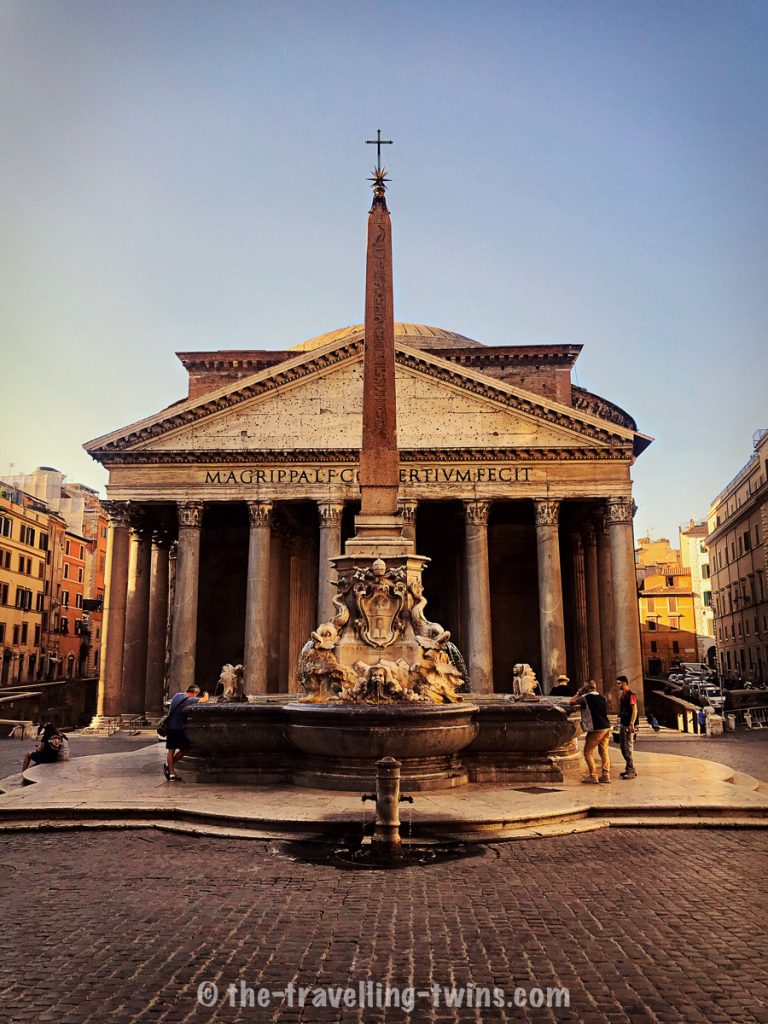
Fontana della Pigna
Pigna (The Pine Cone) is a fountain located on the wall of the Vatican and facing the Cortile della Pigna in Vatican City. Initially, the fountain was located near the Pantheon close to the Temple of Isis but was transferred to its current location in 1608 after a short stint at the Old St. Peter’s Basilica.
Fontana delle Tartarughe
Built in the 1580s, Fontana delle Tartarughe initially featured four statues of boys holding dolphins, which were replaced by turtles later on.
The fountain is one of the late Italian Renaissance and is located in Piazza Mattei in the Sant’Angelo district.
It is believed that the fountain was built by either Gian Lorenzo Bernini or Andrea Sacchi.
Fontana delle Anfore
Fontana delle Anfore is located Piazza dell’Emporio and was built in 1927 by sculptor Pietro Lombardi. Initially, it was built on the Piazza Mastro Giorgio (currently Piazza Testaccio) but was later moved to its current location in 1935 to the consent of Lombardi.
Fontana di Piaza Nicosia
This fountain in the Valle Giulia was immortalized in the symphonic poem called Fontane di Roma by Ottorino Respighi.
Fontane di Piazza Nicosia
As the first of modern Rome’s fountains, Fontana di Piazza Nicosia is one of the most impressive fountains in the city. It is located in the Piazza Nicosia square and was built after the renovation of the Acqua Vergine aqueduct by Giacomo della Porta.
The fountain was initially situated in the Piazza del Popolo around an obelisk but was judged to be too small for the large Piazza Nicosia.
Fontana del Pianto
Also known as Fontana Piazza delle Cinque Scole, this fountain is located in the Piazza delle Cinque Scole in the rione of Regola. The name of the fountain was influenced by the church of Santa Maria del Pianto, which is nearby.
The design of the fountain is attributed to Giacomo Porta and was commissioned by Pope Gregory XIII and built by Pietro Gucci between 1591 and 1593.
Fontana della Piazza dei Quiriti
Fontana della Piazza dei Quiriti is located at the center of the Prati rione in Rome and is named after the people of the city of Cures, the Curites, or Quirites who founded Rome.
Fontana delle Rane
Completed in 1927, Fontana delle Rane or Fountain of the Frogs is located in the heart of Piazza Mincio in Coppede district. The architect Gino Coppede was tasked with building the fountain between 1921 and 1927.
Fontana del Mascherone
Translating to the Big Mask Fountain, Fontana del Mascherone is connected to the wall of the Farnese Palace where Giulia starts.
It was designed around 1626 by Girolamo Rainaldi and is built from granite, travertine, and marble as well as some metallic insertions.
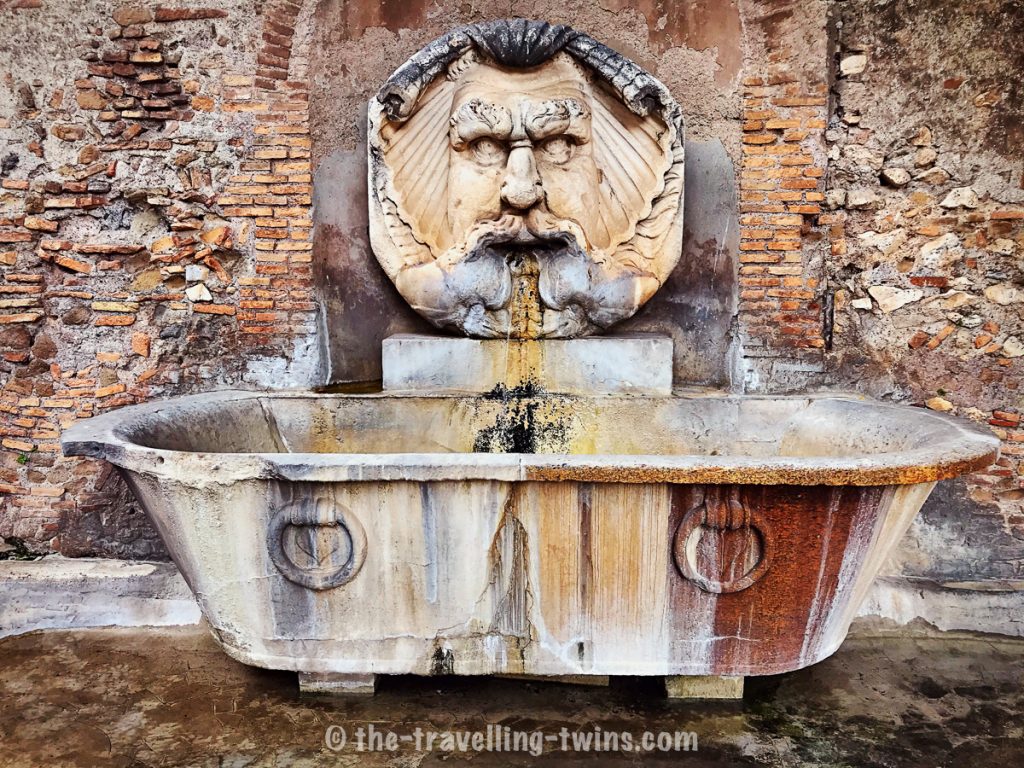
Quattro Fontane
The Four Fountains are located at the junction of Via del Quirinale and Via delle Quattro in Rome and were commissioned by Pope Sixtus V and completed by Muzio Mattei between 1588 and 1593.
One of the fountains is believed to represent the River Tiber and the other the River Aniene.
Can you drink from fountains in Rome?
It is completely safe to drink from any of Rome’s fountains free of charge. It should be remembered that the fountains were built to serve sources of clean drinking water for the residents of Rome.
Did ancient Rome have fountains?
Yes, the Ancient Romans were known for their skills in building an extensive system of aqueducts from lakes and mountain streams to supply water to the many fountains and baths that were scattered around the city. Ancient Rome was also known throughout the world as the city of fountains.
Fountains in Rome – Pin it



Privacy Policy Disclaimer
This website uses affiliate links for income and support.
If you like our website, please consider using these links. You will be directed to the vendor, and we will get a small commission on your purchase price at no increased cost to you.
We have researched facts stated here as far as practicable but please check anything critical before committing your time and money. We do not claim any special knowledge or expertise, and we are not consultants for our readers.